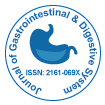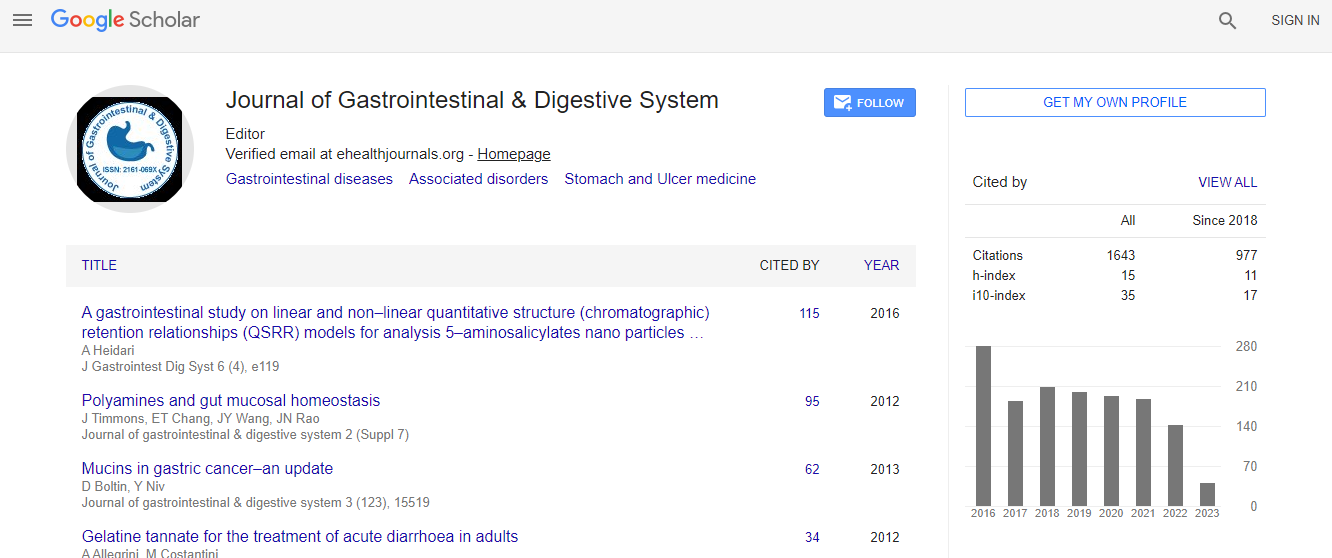Our Group organises 3000+ Global Conferenceseries Events every year across USA, Europe & Asia with support from 1000 more scientific Societies and Publishes 700+ Open Access Journals which contains over 50000 eminent personalities, reputed scientists as editorial board members.
Open Access Journals gaining more Readers and Citations
700 Journals and 15,000,000 Readers Each Journal is getting 25,000+ Readers
Google Scholar citation report
Citations : 2091
Journal of Gastrointestinal & Digestive System received 2091 citations as per Google Scholar report
Journal of Gastrointestinal & Digestive System peer review process verified at publons
Indexed In
- Index Copernicus
- Google Scholar
- Sherpa Romeo
- Open J Gate
- Genamics JournalSeek
- China National Knowledge Infrastructure (CNKI)
- Electronic Journals Library
- RefSeek
- Hamdard University
- EBSCO A-Z
- OCLC- WorldCat
- SWB online catalog
- Virtual Library of Biology (vifabio)
- Publons
- Geneva Foundation for Medical Education and Research
- Euro Pub
- ICMJE
Useful Links
Recommended Journals
Related Subjects
Share This Page
Higher efficacy of sequential therapy with pegylated interferon-alpha 2b and tenofovir compared to tenofovir monotherapy in HBeAg positive chronic hepatitis B patients
9th Euro Global Gastroenterology Conference
Ankur Jindal, Manoj Sharma and Shiv K Sarin
Institute of Liver and Biliary Sciences, India
Posters & Accepted Abstracts: J Gastrointest Dig Syst
Abstract
Introduction: Monotherapy with PEG-interferon (PEG-IFN-�?±) or nucleotide analogues (NA) are largely ineffective in chronic hepatitis B (CHB) patients. A sequential combination therapy may have better therapeutic effects by sustained viral suppression combined with immunomodulation. Aim: To Study the high efficacy of sequential therapy with pegylated interferon-alpha 2b and tenofovir compared to tenofovir monotherapy in HBeAg positive chronic hepatitis B patients. Methods: One hundred twenty six treated naive HBeAg (+) CHB patients with moderately elevated alanine aminotransferase (ALT) (48-200 IU/mL) received tenofovir 300 mg/day for 72 weeks with PEG-IFN-a2b 1.5 mcg/kg per week added after first 12 weeks (lead-in-period) for 24 weeks (sequential combination therapy; ST) or tenofovir monotherapy; 300 mg/day for 72 weeks (TM). Primary end point was rate of HBeAg loss. Biochemical and virological responses were assessed at weeks 12, 36, 48 and 72 weeks. Combined virological response (CVR) [HBeAg loss and HBV DNA<2000 IU/ml at week 72] was also determined. Results: At week 72, HBeAg loss occurred in 35.8% in ST group and 17% in TM group (P=0.028; OR: 2.73, 95% CI: 1.09 to 6.79). Combined virological response (CVR) was seen in 20.8% and 11.3% (P<0.05), respectively. No patients on ST group had HBeAg seroreversion at last follow up. At week 72, undetectable HBV DNA was seen in 77.4% (ST group) vs. 71.7% (TM group); (p=0.51) and normal ALT was seen in 62.3% and 52.8% (p=0.32), respectively. Significantly more patients on ST group had >3Log HBV DNA reduction at week 36 (92.5%) compared to TM group (66%) (P=0.001). Four (7.5%) patients on ST achieved HBsAg loss compared with MT (1 patient, 1.8%) by week 72. No patient had treatment related major adverse effect requiring discontinuation of therapy. Conclusion: 24 weeks of PEG-IFNa2b as add-on sequential regimen to TDF is safe and resulted in more HBeAg and HBsAg loss, when compared to TDF monotherapy in selected HBeAg (+) chronic hepatitis B patients. Long-term follow-up trials are needed to assess for sustained durable response.Biography
Email: ankur.jindal3@gmail.com

 Spanish
Spanish  Chinese
Chinese  Russian
Russian  German
German  French
French  Japanese
Japanese  Portuguese
Portuguese  Hindi
Hindi 
